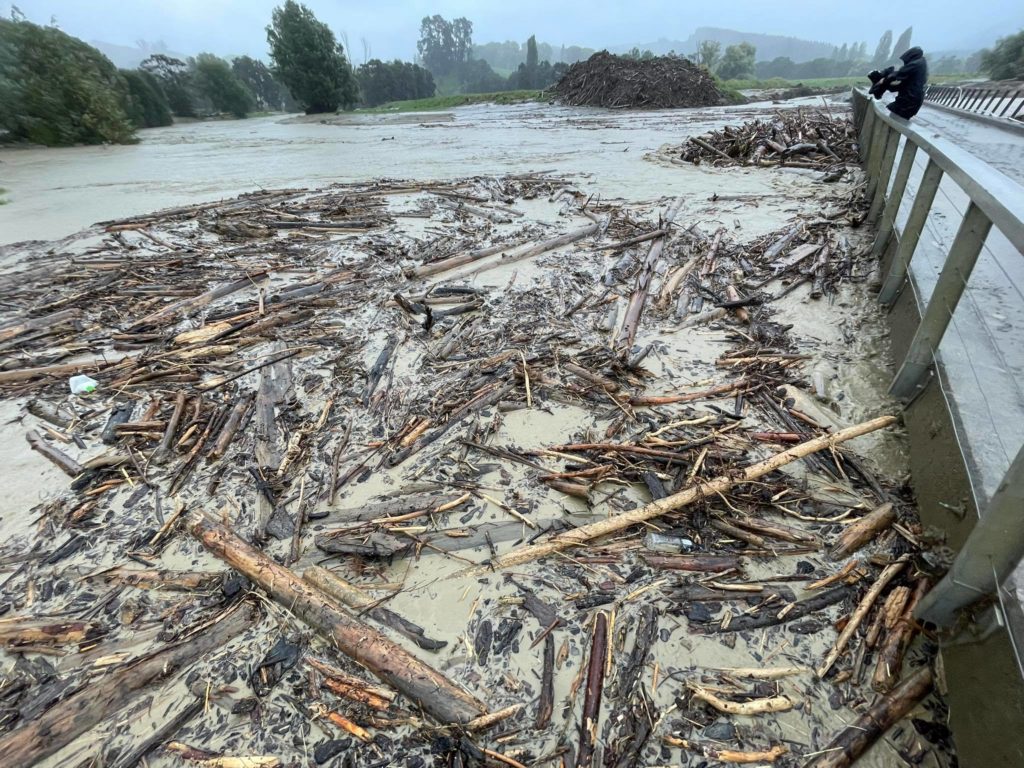Image: Forestry slash and flooding near Gisborne. Photo courtesy of Gisborne City Council.
The Labour Party and the Green Party have had a Cooperation Agreement for the current Parliament. Under the agreement the Greens got two ministers, both outside Cabinet. James Shaw continued as Minister of Climate Change, a post he held in the 2017-2020 government, and obtained Associate Minister for the Environment (Biodiversity). Marama Davidson became Minister for the Prevention of Family and Sexual Violence, a position previously held by Green MP Jan Logie. Davidson also picked up Associate Minister of Housing (Homelessness). The areas of work of these ministries became agreed areas of cooperation. In return Labour obtained the Greens’ commitment to support the government on confidence and supply, and support of the government’s position covered by the areas of cooperation. Outside these areas of cooperation the Greens have been at liberty to develop their own policies. The confidence and supply parts of the agreement have bolstered Labour’s position in Parliament by ensuring Green Party votes in any confidence motion and on budgets.
The formalities of the Cooperation Agreement do not adequately describe the political gains of the respective parties. The Labour Party gained hugely by buying off opposition to the government from the left. Imagine the criticism that the Greens would have levelled against Labour on climate change had a Labour MP been the Minister of Climate Change and been as ineffective as James Shaw. It is not only on climate change have Labour bought the Greens’ quiescence. The closeness of the Greens’ leadership to Labour pre-dates the present Cooperation Agreement. The government’s Budget Responsibility Rules, which have restricted public spending to the extent that services have been underfunded and are now in crisis, begins with the words, ‘The Labour Party and the Green Party agree to abide by these Budget Responsibility Rules in government after the 2017 election.’ Furthermore, the Green contingent in Parliament have not rebelled against the government’s attack on living standards in this period of high inflation. All in all, Labour have successfully bought off Green Party opposition in general inside Parliament and without.
Considering that James Shaw’s career before politics was with PWC and HSBC, it is not surprising that his approach to climate change is limited to market forces and gradual reform. Under the Labour and Green regime progress on emissions has been glacial. Their key component to tackle climate change is the Emissions Trading Scheme (ETS). A report on RNZ of 14 July explains: “The Emissions Trading Scheme (ETS) is a government-run market designed to control emissions by requiring companies that release pollution to pay for credits according to the amount of emissions the create. The plan is to raise the prices over time, encouraging companies to innovate and to pollute less.”
In May, Lawyers for Climate Action took the Minister for Climate Change to court. A report on RNZ said: “The group argues the scheme’s current settings are not consistent with New Zealand’s emissions reduction targets. It stems from a Cabinet decision late last year to reject advice from the Climate Change Commission that would allow the carbon price to rise, citing the cost of living. Since then the carbon price has tanked, causing a $1.2 billion hit to government revenue.” The High Court ruled against James Shaw who has been given to 30 September to reconsider ETS settings. All this is highly embarrassing to the Green Party minister and the government as a whole.
Market mechanisms cannot be relied upon to reduce emissions radically. The ETS scheme does not challenge the underlying capitalist system that caused, and continues to exacerbate, the climate crisis through the endless pursuit of profit. For one, the scheme does not include the agriculture sector, the number one emitter of greenhouse gasses. The ETS approach fails to recognize the inherent contradiction between capitalism and environmental sustainability.
True to form, the government was backtracking from its commitment around climate change even before all this. Ironically, the government announced its reversal in policies around climate action immediately after the devastation that Cyclone Gabrielle wrecked on much of the North Island, one of the biggest disasters caused by global warming.
The ETS has been around in New Zealand for fifteen years now – that is plenty of time to bring the agriculture sector into line. Yet the biggest emitters of New Zealand greenhouse gases still continue to get a free pass. It is not just dairy farming though. Other carbon-intensive industries like steel, aluminum, and wood processing continue to enjoy massive subsidies in the form of carbon credits from the government to allow emissions to continue. Moreover, these sectors have been able to stockpile credits that have been over-allocated to them so that these stockpiles can be used at a later time for more inaction.
In March this year, the government announced yet another public subsidy scheme, to the tune of $140 million, to de-carbonise NZ Steel. Undoubtedly, other big emitters will see this deal as a precedent for the government to subsidise their carbon reduction efforts.
With all the focus on corporate emissions, the ETS does not take into account a ‘just transition’ for workers and communities affected by the necessary shift away from fossil fuels. Without robust mechanisms to support affected workers and ensure retraining, job security, and social welfare, the scheme risks leaving behind those whose livelihoods are tied to polluting industries. This neglect of social justice and workers’ rights is incompatible with a truly sustainable and equitable approach.
Labour and the Greens are committed to the market. But it will take radical action by a government to make Aotearoa carbon neutral. An anti-capitalist workers’ government could provide: electrified freight and public transport; walking and cycling infrastructure; high-quality, carbon-neutral public housing; green building codes; abundant electric power from solar and wind generation; and investment in tertiary education research to find solutions to global warming and the environmental degradation caused by capitalism. Such a government would be on a collision course with a capitalist ruling class. So we need to face reality: solving climate change will involve an epic class struggle to wrest control of society from the capitalists’ greedy clutches.








